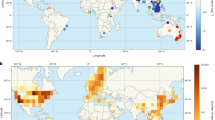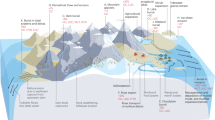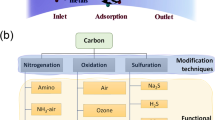The natural contamination of drinking water by arsenic needs to be urgently addressed.
Abstract
The pollution by naturally occurring arsenic of alluvial Ganges aquifers, which are used for the public water supply in Bangladesh and West Bengal, has been discussed by Nickson et al.1. We agree with their main conclusion that arsenic is released by reductive dissolution of iron oxyhydroxides, as was proposed earlier2. Our observations indicate that arsenic- rich pyrite and other arsenic minerals, which were proposed in previous models (cited by Nickson et al.1) to give rise to arsenic pollution, are rare or even absent in the sediments of the Ganges delta. We believe that arsenic is more likely to be co-precipitated with or scavenged by iron (III) and manganese (IV) in the sedimentary environment.
Similar content being viewed by others
Main
Nickson et al.1 suggested that the arsenic in these alluvial sediments is derived from sulphide deposits in the Ganges basin. However, the copper belt of Bihar, which contains small amounts of arsenopyrite, and the coal basins of the Damodar valley, which contain moderate concentrations of arsenic, are drained by rivers that flow far to the south of the Ganges tributary system (Fig. 1). We suggest that there are several more likely sources of sedimentary arsenic, including the Gondwana coal seams in the Rajmahal basin, which contain up to 200 parts per million (p.p.m.) of arsenic; isolated outcrops of sulphides in the Darjeeling Himalayas, which contain up to 0.8% arsenic; and other sources in the upper reaches of the Ganges river system.
The Ganges alluvial tract upstream of Rajmahal, in the states of Bihar and Uttar Pradesh, does not suffer from large-scale arsenic contamination. This indicates that the Quaternary sediments around the Ganges delta have characteristic features that favour the initial retention and subsequent release of arsenic. These sediments have high proportions of clay and contain relatively large amounts of organic carbon, and are thicker towards the south3,4. The average arsenic content in cores from boreholes in West Bengal is higher in layers of clay (9.5–12 p.p.m.) than of sand (3.8–4.8 p.p.m.)5. Quaternary sediments in the Ganges alluvial tract in Bihar and Uttar Pradesh contain more sand and are much narrower than sediments in the Bengal basin, which may explain why they retain less arsenic.
The groundwater of Uttar Pradesh and Bihar has trace concentrations of iron (0 to 0.7 mg per litre) compared with higher values in West Bengal (up to 36 mg per litre) and Bangladesh (30 mg per litre)1. The relatively low values of dissolved iron upstream of the Ganges delta indicate that the environment may not be sufficiently reducing to mobilize iron and arsenic.
Nickson et al.1 reported that arsenic concentration increases with depth in wells at Manikganj, Faridpur and Tungipara in Bangladesh. However, this observation appears to be site specific, as the large database5,6,7 for aquifers in West Bengal indicates that arsenic decreases with depth (Fig. 2).
During the past thirty years, ground-water has been used increasingly for irrigation and the use of phosphate fertilizers has increased threefold. More than 0.5 million tubewells with handpumps, 0.1 million shallow tubewells, and 3,000 deep tubewells have been sunk at depths of 10–20 m, 30–100 m and 50–200 m, respectively8,9. This widespread withdrawal of ground-water may have mobilized phosphate derived from fertilizers and from the decay of natural organic materials in shallow aquifers. The increase in phosphate concentration could promote the growth of sediment biota and the desorption of arsenic from sediments. These combined microbiological and chemical processes might have increased the natural mobility of arsenic.
The efficiency with which arsenic is removed by adsorption onto iron-coated sand10 and by adsorption on and co-precipitation with ferrihydrite11 depends on both the arsenic oxidation state and the ratio of iron to arsenic. The proposed removal of arsenic by simple aeration1 of anoxic water must therefore be approached with caution.
References
Nickson, R. et al. Nature 395, 338 (1998).
Bhattacharya, P. et al. Int. J. Water Res. Dev. 13, 79–92 (1997).
Hiller, K. Geol. Jahrb. D 90, 3–35 (1988).
Mukherjea, A. & Hazra, S. Ind. J. Geol. 69, 41–54 (1997).
Center for the Study of Man and the Environment, Calcutta (unpublished data).
Central Groundwater Board, New Delhi (unpublished data).
Geological Survey of India, Calcutta (unpublished data).
Bagla, P. & Kaiser, J. Science 274, 174–175 (1996).
Mallick, S. & Rajagopal, N. R. Curr. Sci. 70, 956–958 (1996).
Joshi, A. & Chaudhuri, M. J. Env. Eng. ASCE 122, 769–771 (1996).
Wong, P. L. N., Huang, J. C. Y. & Cheng, T. W. J. Chin. Inst. Env. Eng. 5, 241–251 (1995).
Author information
Authors and Affiliations
Rights and permissions
About this article
Cite this article
Acharyya, S., Chakraborty, P., Lahiri, S. et al. Arsenic poisoning in the Ganges delta. Nature 401, 545 (1999). https://doi.org/10.1038/44052
Issue Date:
DOI: https://doi.org/10.1038/44052
This article is cited by
-
Oral bioaccessibility of potentially toxic elements (PTEs) and related health risk in urban playground soil from a medieval bell metal industrial town Khagra, India
Environmental Geochemistry and Health (2023)
-
Effect of landfill leachate on arsenic migration and transformation in shallow groundwater systems
Environmental Science and Pollution Research (2023)
-
Role of physical environment in groundwater contamination by arsenic in parts of West Bengal, India
Journal of Earth System Science (2023)
-
Aquifer Mapping in Parts of Murshidabad and Adjoining Birbhum Districts, West Bengal, India
Journal of the Geological Society of India (2022)
-
Anthropogenic arsenic menace in contaminated water near thermal power plants and coal mining areas of India
Environmental Geochemistry and Health (2022)
Comments
By submitting a comment you agree to abide by our Terms and Community Guidelines. If you find something abusive or that does not comply with our terms or guidelines please flag it as inappropriate.





